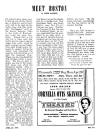| Home Page
Meet Boston Menu
Index
In colonial days, when manufacturing was strictly forbidden in America, and all such work had to be kept strictly under cover and their products "bootlegged," work on the Quincy quarries (then in the limits of Braintree) was under the same handicap. Granite bars with ruts cut in them were laid end-to-end to make a special wagon trail which could be easily covered up and hidden from sight though easily followed by wagons fitting the tracks, and connected the quarries with Braintree and with the Neponset River. These may be considered the first railroad tracks in existence. The ban on such industry was one of the important issues over which the Revolution started. After independence, the need for concealment was over, and the granite rails in Braintree fell into disuse for a while, though there were several attempts to revive the road as some sort of turnpike or toll-road. In 1820, when the introduction of steam trains was being considered in this country, the "Granite Railroad" was among the first to be turned to that use―again for its original purpose of hauling granite from the quarries. Before long, it became necessary to plan on extending this line in to Boston itself. This became possible when the Old Colony Railroad―connecting Boston with points south . . . started construction, leased the Granite Railroad, and connected the latter with its own lines along the south side of the Neponset River. Thus the Granite line . . . later converted into iron rails . . . was brought into Boston across Dorchester and by a bridge built from Dorchester Neck (now South Boston) over Fort Point Channel into town. The Boston Terminal of this line was on Kneeland Street; on annex, separated from the main depot by an alley which is now port of Atlantic Avenue, handled just the train service running down to Fall River to connect with the old Fall River Line boats to New York. It was from this annex depot that the Boston regiment started in 1861 that was the first to go down South in the Civil War, that got into the first fight of that war at Baltimore, and that held Washington alone for many weeks. The main Old Colony depot was abandoned when South Station was built. The old annex has been incorporated into the new station, as the express building. * There are 7287 streets in Greater New York, And over 18,000 in Greater Boston. * Fairy tales are full of the favorite plot of the hero who spends a lifetime of adventure wandering over the earth to find his lost one in some distant magical land whose whereabouts are never told. An Irish ballad was once more specific. It said: "He sailed east, he sailed west,
|
